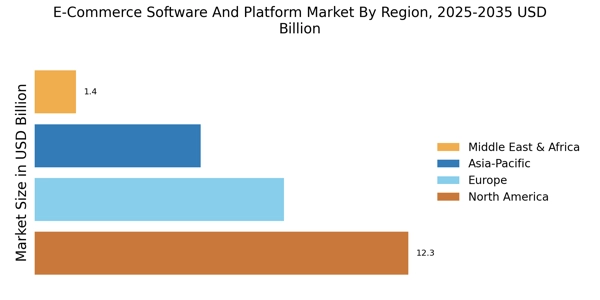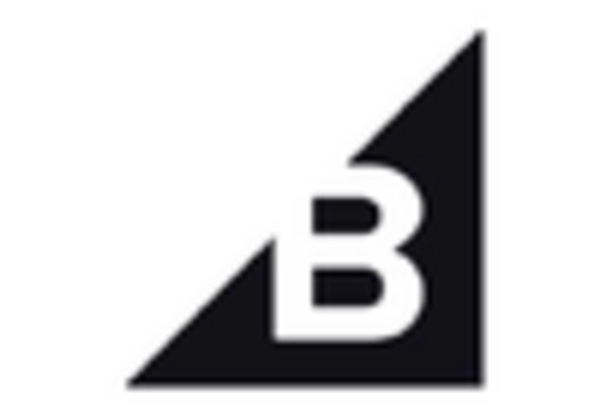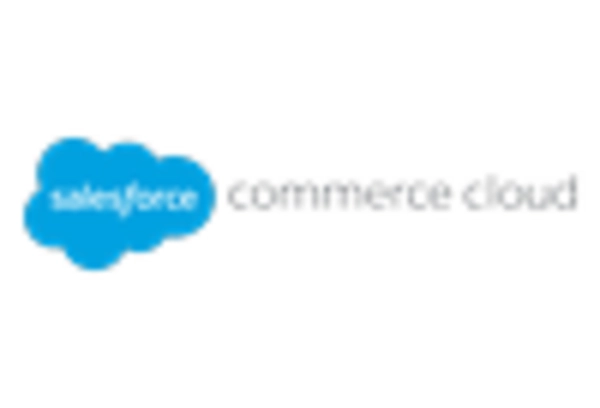Expansion of Payment Solutions
The E-Commerce Software And Platform Market is significantly influenced by the expansion of diverse payment solutions. As consumers become more comfortable with online transactions, the need for flexible and secure payment options has surged. This includes the integration of digital wallets, cryptocurrencies, and buy-now-pay-later services. Recent statistics indicate that nearly 60% of consumers prefer platforms that offer multiple payment methods. Consequently, e-commerce platforms are adapting by incorporating various payment gateways to cater to this demand. This trend not only enhances user experience but also reduces cart abandonment rates, thereby driving growth in the E-Commerce Software And Platform Market.
Adoption of Cloud-Based Solutions
The E-Commerce Software And Platform Market is being propelled by the widespread adoption of cloud-based solutions. These platforms offer scalability, flexibility, and cost-effectiveness, making them attractive to businesses of all sizes. The ability to access e-commerce software from anywhere and the reduced need for on-premises infrastructure are compelling advantages. Recent data indicates that the cloud computing market is expected to grow at a compound annual growth rate of over 15% in the coming years. This trend is likely to enhance the capabilities of e-commerce platforms, allowing businesses to innovate and adapt quickly to changing market demands, thus driving the E-Commerce Software And Platform Market.
Growing Importance of Cybersecurity
The E-Commerce Software And Platform Market is increasingly shaped by the growing importance of cybersecurity. As online transactions become more prevalent, the risk of cyber threats escalates, prompting businesses to prioritize security measures. Consumers are more likely to engage with platforms that demonstrate robust security protocols, including encryption and fraud detection systems. Recent surveys indicate that nearly 70% of consumers are concerned about the security of their personal information when shopping online. Consequently, e-commerce platforms are investing in advanced cybersecurity solutions to build trust and protect customer data, which is likely to drive growth in the E-Commerce Software And Platform Market.
Increased Focus on Omnichannel Retailing
The E-Commerce Software And Platform Market is experiencing a paradigm shift towards omnichannel retailing. Retailers are increasingly recognizing the importance of providing a seamless shopping experience across multiple channels, including online, mobile, and physical stores. This approach allows consumers to interact with brands in a cohesive manner, regardless of the platform they choose. Data suggests that businesses employing omnichannel strategies can achieve a 10% increase in customer retention rates. As a result, e-commerce platforms are evolving to support integrated solutions that facilitate this omnichannel approach, thereby driving growth in the E-Commerce Software And Platform Market.
Rising Demand for Personalized Shopping Experiences
The E-Commerce Software And Platform Market is witnessing a notable shift towards personalized shopping experiences. Consumers increasingly expect tailored recommendations and customized interfaces that cater to their individual preferences. This trend is driven by advancements in data analytics and machine learning, which enable platforms to analyze user behavior and preferences effectively. As a result, businesses are investing in sophisticated e-commerce solutions that facilitate personalized marketing strategies. According to recent data, companies that implement personalized experiences can see conversion rates increase by up to 20%. This growing demand for personalization is likely to propel the E-Commerce Software And Platform Market forward, as businesses strive to enhance customer satisfaction and loyalty.


















Leave a Comment